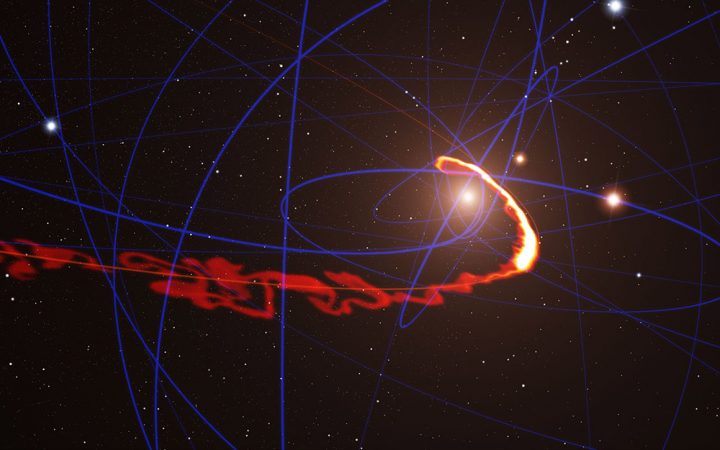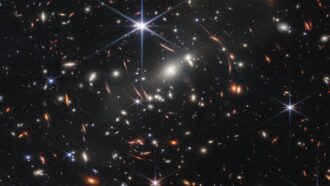Feasting black hole
A huge gas cloud is being stretched, shredded and destroyed by the black hole at the center of the Milky Way

ESO/S. Gillessen/MPE/Marc Schartmann
The giant black hole at the center of our galaxy soon will shred a giant cloud of gas. And thanks to powerful telescopes, astronomers on Earth will be watching closely when the black hole’s gravity begins ripping the cloud apart, sometime in 2014.
Astronomers first noticed the cloud in 2011. Called G2, it was dangerously close to the black hole at the center of the Milky Way. A black hole is a region in space where nothing that gets close — even light— can escape its gravity.
Even in 2011, the black hole’s gravity had begun to stretch and squash G2. By April 2013, astronomers captured more images of this cloud with the Very Large Telescope in Chile’s Atacama Desert. Astronomers now find that the edge of the cloud already has been whisked to the black hole’s far side.
“If you think of the cloud as a roller coaster train, the first carriage has already swung by the black hole,” Stefan Gillessen told Science News. “The main part of the train is still in approach.” An astronomer, Gillessen works at the Max Planck Institute for Extraterrestrial Physics in Garching, Germany. His team’s findings will appear soon in Astrophysical Journal.
Because of the black hole’s pull, G2 now races through space at 100 times Earth’s speed around the sun. That pull of gravity also has stretched the cloud to twice as long as it had been a year earlier. Astronomers predict that most of the cloud will meet the black hole at some time before the summer of 2014. They expect to use telescopes around the world to watch the spectacle.
As the cloud stretches, it may vanish from view — perhaps even before Jan. 1, 2014, Dimitrios Giannios told Science News. This astrophysicist at Purdue University in West Lafayette, Ind., did not work on the new study. The black hole may take an additional few years to suck in the last shreds of G2. And when it does, a spectacular cosmic fireworks display may erupt.
Explains Giannios, “It would be a last echo of the death of this cloud.”
Power Words
black hole A region of space having a gravitational field so intense that no matter nor radiation can escape.
gravity The force that attracts any body with mass, or bulk, toward any other body with mass. The more mass there is, the more gravity there is.
astronomy The area of science that deals with celestial objects, space and the physical universe as a whole.
astrophysics An area of astronomy that deals with understanding the physical nature of stars and other objects in space.







